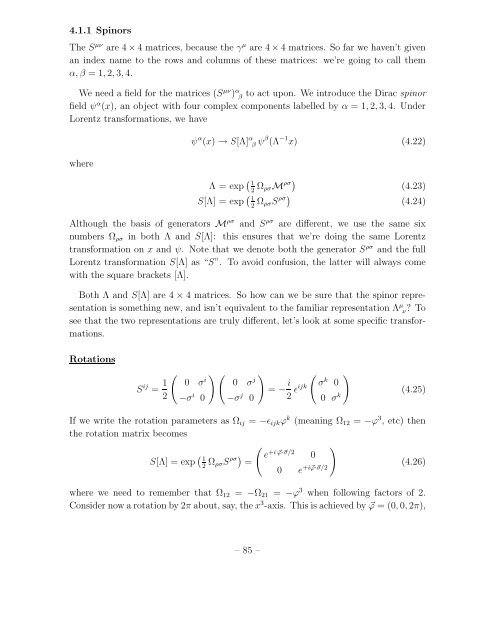Quantum Field Theory
Quantum Field Theory
Quantum Field Theory
You also want an ePaper? Increase the reach of your titles
YUMPU automatically turns print PDFs into web optimized ePapers that Google loves.
4.1.1 SpinorsThe S µν are 4 × 4 matrices, because the γ µ are 4 × 4 matrices. So far we haven’t givenan index name to the rows and columns of these matrices: we’re going to call themα, β = 1, 2, 3, 4.We need a field for the matrices (S µν ) α β to act upon. We introduce the Dirac spinorfield ψ α (x), an object with four complex components labelled by α = 1, 2, 3, 4. UnderLorentz transformations, we havewhereψ α (x) → S[Λ] α β ψ β (Λ −1 x) (4.22)Λ = exp ( 12 Ω ρσM ρσ) (4.23)S[Λ] = exp ( 12 Ω ρσS ρσ) (4.24)Although the basis of generators M ρσ and S ρσ are different, we use the same sixnumbers Ω ρσ in both Λ and S[Λ]: this ensures that we’re doing the same Lorentztransformation on x and ψ. Note that we denote both the generator S ρσ and the fullLorentz transformation S[Λ] as “S”. To avoid confusion, the latter will always comewith the square brackets [Λ].Both Λ and S[Λ] are 4 × 4 matrices. So how can we be sure that the spinor representationis something new, and isn’t equivalent to the familiar representation Λ µ ν ? Tosee that the two representations are truly different, let’s look at some specific transformations.RotationsS ij = 1 2( ) ( )0 σi 0 σj−σ i 0−σ j 0= − i 2 ǫijk (σ k 00 σ k )(4.25)If we write the rotation parameters as Ω ij = −ǫ ijk ϕ k (meaning Ω 12 = −ϕ 3 , etc) thenthe rotation matrix becomesS[Λ] = exp ( ( )1Ω 2 ρσS ρσ) e+i ⃗ϕ·⃗σ/20=(4.26)0 e +i⃗ϕ·⃗σ/2where we need to remember that Ω 12 = −Ω 21 = −ϕ 3 when following factors of 2.Consider now a rotation by 2π about, say, the x 3 -axis. This is achieved by ⃗ϕ = (0, 0, 2π),– 85 –
















